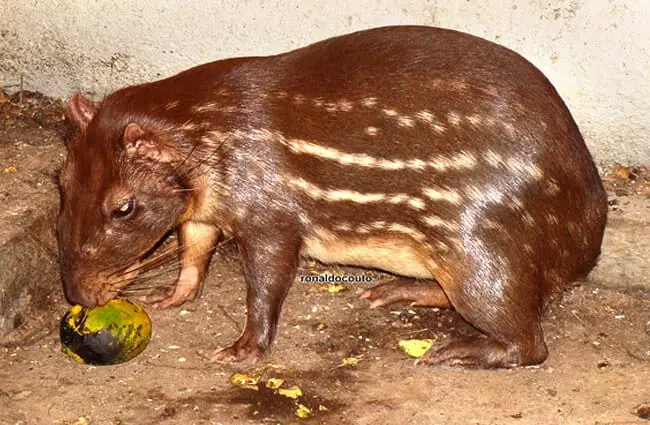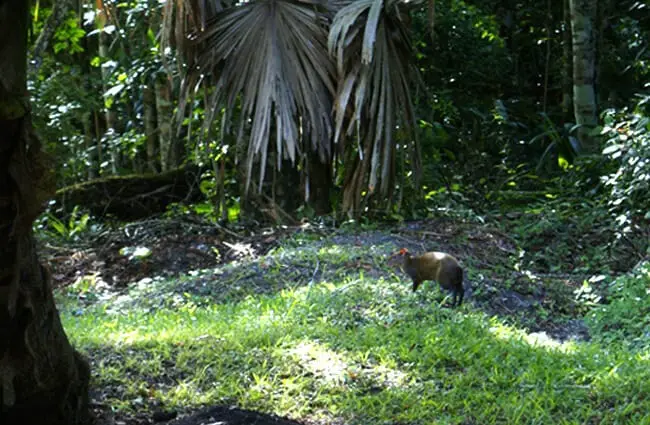The rainforest floor holds many secrets, and among the most intriguing is the paca. Often overlooked, these large rodents play a vital, though subtle, role in the ecosystems they inhabit. This guide delves into the world of pacas, exploring their biology, behavior, habitat, and relationship with both the natural world and humans.
What is a Paca?
Pacas, members of the Caviidae family, are large rodents native to Central and South America. There are two main species: the lowland paca (Cuniculus paca) and the mountain paca (Cuniculus tschudii). They resemble oversized guinea pigs, but with longer legs and a more streamlined body, perfectly adapted for navigating the dense undergrowth of their forest home. Their distinctive appearance includes coarse fur, typically a reddish brown to grayish color, adorned with rows of white spots – a camouflage pattern that helps them blend seamlessly into the dappled sunlight of the forest floor.

Physical Characteristics
Adult pacas typically weigh between 6 and 14 kilograms and measure 70 to 120 centimeters in length. Their legs are relatively long and powerful, enabling them to run quickly and jump with surprising agility. They possess partially webbed feet, advantageous for traversing muddy terrain. A short, but noticeable tail further contributes to their balanced movement. Their teeth, like all rodents, are constantly growing, requiring continuous gnawing to keep them at a manageable length.
Habitat and Distribution
Pacas are found throughout the tropical forests and grasslands of Central and South America, ranging from southern Mexico to northern Argentina. The lowland paca prefers dense, humid lowland forests, often near water sources such as rivers and swamps. The mountain paca, as its name suggests, inhabits higher elevation cloud forests and montane grasslands. Both species favor areas with thick undergrowth, providing cover from predators and a source of food. They create burrows and tunnels within dense vegetation, often near streams or fallen logs.
Diet and Feeding Habits
Pacas are primarily frugivores, meaning their diet consists largely of fruits. They have a particular fondness for fallen fruits, but they also consume seeds, nuts, roots, leaves, and occasionally insects. They are opportunistic feeders, and their diet varies depending on the availability of food in their habitat. They play a crucial role in seed dispersal, consuming fruits and depositing the seeds in different locations through their droppings. This contributes to forest regeneration and maintains biodiversity. They are nocturnal feeders, emerging from their burrows at night to forage for food.

Finding Food in the Wild
Observing a paca’s feeding behavior requires patience and a keen eye. Look for partially eaten fruits and seeds on the forest floor. They often create small pathways through the undergrowth as they move between feeding sites. Their droppings are also a telltale sign of their presence – dark, pellet-shaped, and often containing undigested seeds.
Evolutionary History
The evolutionary history of pacas dates back to the Miocene epoch, roughly 10 to 15 million years ago. They are believed to have originated in South America and gradually diversified into the species we recognize today. Their ancestors were likely smaller rodents that adapted to forested environments. Fossil evidence indicates they have maintained a stable body plan over millions of years, a testament to their successful niche adaptation. Their close relationship with guinea pigs and capybaras supports their classification within the Caviidae family.
Reproduction and Life Cycle
Pacas are generally solitary animals, coming together only during the breeding season. The breeding season varies depending on the geographic location, but it typically occurs during the rainy season. Females give birth to one to four pups after a gestation period of around 120 to 150 days. The pups are born precocial, meaning they are relatively well-developed at birth, with fur and open eyes. They are able to move around and forage for food shortly after birth, but they remain dependent on their mother for several months. Pacas have a relatively long lifespan, living up to 10 years in the wild and even longer in captivity.

Ecological Role and Interactions
Pacas play a vital role in the ecosystems they inhabit. As seed dispersers, they contribute to forest regeneration and maintain plant diversity. They also serve as prey for a variety of predators, including jaguars, ocelots, anacondas, and hawks. Their burrowing activities help to aerate the soil and create habitats for other animals. They often share their burrows with other species, forming a complex web of interactions within the forest community.
Interactions with Other Animals
Beyond predation and mutualistic relationships, pacas sometimes compete with other rodents and mammals for resources. However, their relatively large size and nocturnal habits often allow them to avoid direct competition. They also exhibit a degree of commensalism with certain bird species, which may feed on insects disturbed by the paca’s foraging activities.
Pacas and Humans
Pacas have a long history of interaction with humans. In many parts of Central and South America, they are hunted for their meat, which is considered a delicacy. They are also sometimes kept as pets, although their specific needs make them challenging to care for in captivity. Habitat loss and deforestation pose a significant threat to paca populations, as they rely on intact forests for survival. Conservation efforts are crucial to ensure the long-term viability of these fascinating animals.

Encountering a Paca in the Wild
If you are fortunate enough to encounter a paca in the wild, observe it from a distance and avoid disturbing its natural behavior. Do not attempt to feed or approach it. Respect its space and allow it to move freely. Report any sightings to local wildlife authorities, as this can help with conservation efforts.
Caring for Pacas in Captivity
Caring for pacas in captivity requires a considerable commitment and specialized knowledge. They need a large enclosure with plenty of space to roam and burrow. The enclosure should be equipped with a variety of substrates, such as soil, straw, and leaf litter, to allow them to express their natural behaviors. They require a varied diet consisting of fruits, vegetables, and seeds. They are social animals and should be kept in pairs or small groups. Regular veterinary care is essential to ensure their health and well-being. Pacas are prone to certain health problems, such as dental disease and obesity, so it is important to monitor their diet and provide them with plenty of exercise.
Fun Facts About Pacas
- Pacas are excellent swimmers and often seek refuge in water to escape predators.
- They communicate with a variety of vocalizations, including whistles, grunts, and clicks.
- Their spotted coat provides excellent camouflage in the dappled sunlight of the forest floor.
- They build elaborate burrow systems with multiple entrances and chambers.
- They are nocturnal, most active at night.

The paca, a seemingly unassuming rodent, is a testament to the intricate web of life that sustains our planet’s rainforests. Understanding its biology, behavior, and ecological role is essential for ensuring its survival in a rapidly changing world. By appreciating these fascinating creatures, we can contribute to the conservation of the ecosystems they call home.

![Red Angus Closeup of a beautiful Red Angus cowPhoto by: U.S. Department of Agriculture [pubic domain]https://creativecommons.org/licenses/by/2.0/](https://animals.net/wp-content/uploads/2020/03/Red-Angus-4-238x178.jpg)




![Red Angus Closeup of a beautiful Red Angus cowPhoto by: U.S. Department of Agriculture [pubic domain]https://creativecommons.org/licenses/by/2.0/](https://animals.net/wp-content/uploads/2020/03/Red-Angus-4-100x75.jpg)

